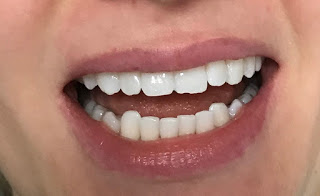How I do I whiten? Let me count the ways.
There sure are a lot of bright smiles seen around NYC these days! I suspect theres a whole lot of whitening going on. For those who are contemplating the achieving whitened teeth what are the ways to accomplish this in 2019?
At the moment, social media is awash with photos of people brushing their teeth with activated charcoal and swearing by it. I wouldn't recommend trying this technique since charcoal seems pretty high on abrasivity to me and who knows what the long term effects are. For the moment, it's probably best to refrain from this new fad, at least until more is known about what consequences it may cause.
What are the more mainstream ways to whiten? Using carbamide peroxide or hydrogen peroxide products. These have been in use for many years and have been shown to effective and don't seem to have unknown risks. The known risks involve tooth sensitivity and gingival irritation. Both of these side effects are transitory and disappear when a person stops using the whitening product.
Currently in my dental office I offer three different ways of whitening. Starting from the "Deluxe" to basic, here are my favorite ways.
1) In office chairside whitening using very strong hydrogen peroxide gel and a light to help energize the peroxide. I'm not sure the light does much, but it is claimed to enhance the process. I am using The Zoom Advanced 3 system with an ultra violet light, but am about to switch to the upgraded visible light spectrum unit made by phillips that is the Zoom replacement for my old unit.
The technique I employ involves propping my patients mouth ope with a special cheek retractor and masking the gums with an opaque block out material. This covers any exposed gingiva and protects it from burns from the bleaching gel ( 25% hydrogen peroxide) or the U.V. light waves. After a careful isolation ( taking 5 -10 minutes to perform) the gel is placed on teeth and exposed to the light for 15 minutes. Afterwards I remove the bleaching gel from the teeth using a high speed suction and then wiping with a cotton 2x2 moistened with water. I then reapply more gel. I apply the gel a total of 4 cycles. Afterwards I remove the all of the isolation materials I placed and thoroughly wash out my patients mouth. Photographs are taken before and after with a shade guide in place and most of the time the teeth are noticeably whiter afterwards. Sometimes if a patients teeth have marks from enamel hypo-calcification, these appear more noticeable afterwards, but over time ( two to three weeks) these tend to fade.
If a patient is amenable, prior to employing the Zoom system I take alginate impressions so that my assistant can make custom trays to allow my patients to either whiten their teeth further at home or to easily perform whitening touchups down the road, since bleached teeth seem to slowly become less white overtime. Most patients end up wanting a touch up 6 -12 months later.
Custom tray bleaching is great way to whiten teeth. As I have said I also use this technique as an adjunct to in office bleaching treatments. Custom trays are made on models of a patients mouth made from pouring stone into impressions of a patients upper and lower teeth. These models are careful trimmed and modified to allow the fabrication of a well fitting clear custom tray. These are carefully trimmed so that they don't over extend onto the gingiva. Over extended bleaching trays can cause the whitening medium to be held against a patients gums and can cause the gums to experience a temporary "bleaching burn" or gingival inflammation.
Most of my patients now choose a "daytime" bleach (Opalescence 35%) that allows them to wear their trays for thirty minutes at a time during the day. These use formulations that are stronger than 22% carbamide peroxide formulation and work faster as well.
A third option that is quite popular with my patients is using non customized trays- Opalescence Go (15% formulation). These come in a box of ten single use packages. Each package consists of two single use trays that are preloaded with a viscous bleaching gel. that is meant to be worn for about 20 minutes and then thrown away. Many of my patients prefer this technique over Crest Whitestrips because the solution is stronger and also less runny. We offer the box to our patients for $79 dollars and advise them to store it in a refrigerator to better maintain its efficacy.
Toothpastes containing peroxide probably do tend to whiten teeth, but they may have a problem keeping the active peroxide stable in the tubes since once mixed into the paste the peroxide tends to "bubble out". Also the toothpaste doesn't stay on the teeth as long as the other formulations I have previously mentioned. Still, sometimes when questioning a new patient whose teeth seem to have been bleached, they report that the only product they used was a peroxide containing toothpaste, so I believe these can accomplish some whitening when used properly.
I should add that there is no way to bleach restorations since their colors are not subject to change from peroxide based whitening formulas. As such some patients may end up wanting to change some fillings or crowns after whitening their surrounding teeth.Before committing to whitening their teeth, patients should ask their dentist if they have any restorations that may not be affected by the process and if so what will be the cost of changing them afterwards.
from Ask Dr. Spindel - http://lspindelnycdds.blogspot.com/2019/01/how-i-do-i-whiten-let-me-count-ways.html - http://lspindelnycdds.blogspot.com/


Comments
Post a Comment